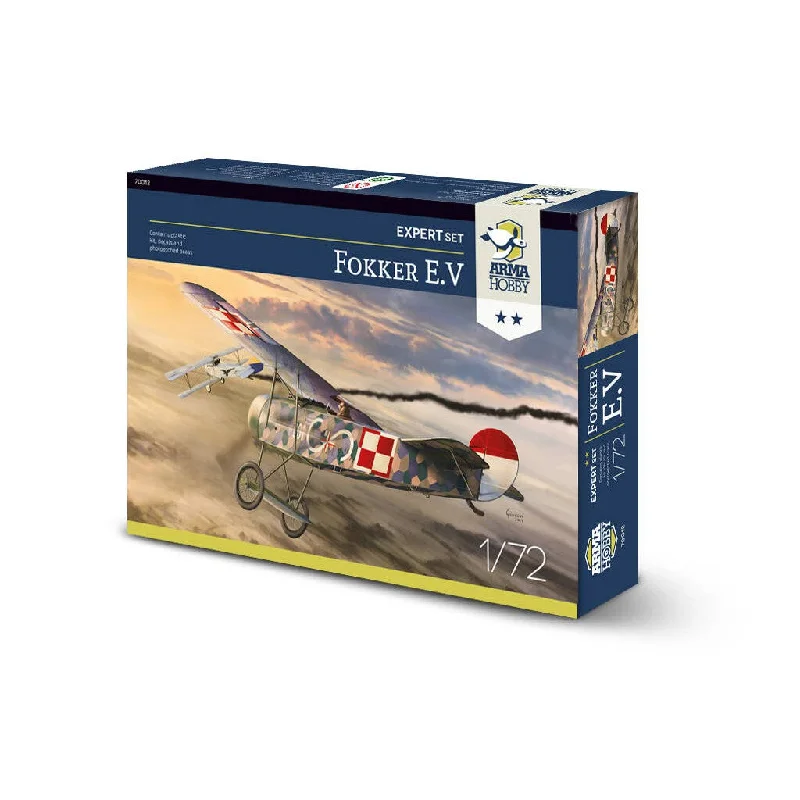The aim of the Second Fighter Contest, convened at the Adlershof German aircraft test centre during May and June 1918, was to choose new airplanes for the Kaiser’s air forces. Unquestioned winner of the rotary engine-powered category was the Fokker E.V, streamlined monoplane with innovative plywood-covered wing. In early August first production examples reached the frontline Army and Naval squadrons. First unit fully-equipped with the new planes was elite Jasta 6, part of the Richthoffen’s Jagdgeschwader I. Pilots on the both sides of the front were impressed with the Fokker’s performance and soon nicknamed it “Flying Razor”. On 17 August Lt. Emil Rolff scored first E.V aerial victory. Alas, in the following days two pilots, including Rolff, were killed when the wings failed in flight. The type has been immediately grounded and the investigation showed serious production faults at the Fokker’s subcontractor, Perzina factory (pre-war piano producer). Fokker quickly replaced the wings with strengthened ones, simultaneously changing the airplane’s designation into D.VIII, but the Armistice was signed before return of the fighters to the front.
Relatively the most active frontline user of the Fokkers E.V/D.VIII was Poland. 17 examples , mostly captured during Wielkopolskie Uprising in winter 1918/1919, have been quickly assembled and some – through Warsaw – were sent to the front. Single planes were assigned to several squadrons (9, 12, 15 and 19), but the fame and glory these fighters gained thanks to participation in fights against Ukrainians over city of Lwów – on strength of the 7. Eskadra Lotnicza (Flying Squadron), later joined by American volunteers and known as “Kosciuszko Squadron”. These planes were piloted by two Polish popular heroes, veterans of the the Great War in the Austro-Hungarian service, kpt. Stefan Bastyr and por. Stefan Stec – the latter famous also as a designer of the white-and-red checkerboard, initially his personal marking, which soon became official Polish air force national insignia used till nowadays.
Polish-Ukrainian War conditions gave few opportunities for dogfights. Polish Fokkers were so much respected that Ukrainians and Austrian mercenaries flying in Ukrainian colours rarely flew over the city of Lwów. Despite the fact that Poles often performed many missions a day, mostly patrolling and ground attacks, only one real fighter’s duel has been fought. On the 29 April 1919 morning, when the Ukrainian reconaissance Brandenburg C.I had been attacked and repelled by Stec’s Fokker, the skirmish has been joined by the Ukrainian Nieuport piloted by the Austro-Hungarian 11-victories ace Franz Rudorfer. After several minutes of the struggle, observed from the ground by many Polish soldiers and civilians, Stec severely hit the enemy Nieuport forcing it to retreat. Despite fact that Rudorfer has been able to hide in the fog and reached home airfield, numerous witnesses considered Ukrainian plane shot down. Stec himself reported only damaging the enemy. A few days later Rudorfer, probably impressed with Polish aviation effectiveness, has hijacked his airplane and defected to Czechoslovakia.
Polish Fokkers later flew many effective ground attack missions during Polish offensive started in early May. There was another, but at that time inconclusive, dogfight against Ukrainian Nieuport and several brave attacks against heavily-defended observation balloons. While every time Polish pilots managed to force the enemy to pull the balloon down, they were not able to finally destroy it. After 14 May the front went more than 100 km to the East so the short-ranged Fokkers were not able to effectively operate from Lwów airbase. In such situation the Command decided to honour the 7. Eskadra with reorganization from general-purpose into purely fighter unit, and rearm it exclusively with factory-fresh Albatros-Oeffag D.III airplanes imported from Austria.
Single Fokkers E.V were used against Soviets till 1920 – one of them, piloted by young and inexperienced por. Julian Jasiński lost his way flying from Warsaw to frontline airfield of 19. Eskadra. Pilot has finally landed in Slavnoye – airbase of the Soviet fighter group led by ace Grigory Shirinkin and the captured airplane has been later used by Soviets. The only Polish Fokker modified to D.VIII standard fought during the most intensive days of the defence of Lwów against Budenny Konarmia (Horse Army). After the end of the hostilities Fokkers, as well-performing and interesting-looking airplane were intensively used in training and during several shows and exhibitions.
Features:
- Plastic parts
- Photoetched parts
- Double sheet Techmod decals: 2 Polish and 2 German colours

